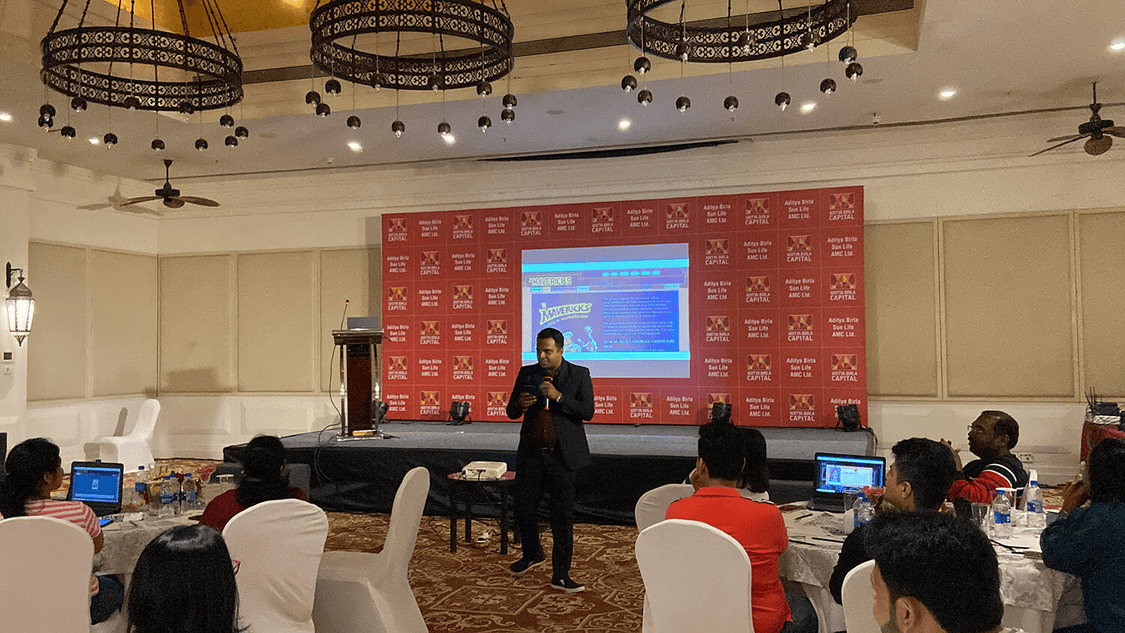
When the skies turn grey and it starts to rain, it can feel like your team-building plans are stuck indoors. But here’s the secret: the best team bonding often happens away from the noise and distractions of the outdoors. Some of the most creative, fun, and productive corporate activities take place inside four walls. Whether you’re trying to energize your team or build deeper connections among new hires, these indoor games are exactly what you need.
Below, we’ve curated 9 creative and highly engaging indoor team building activities for employees that promote collaboration, communication, leadership, and, above all, fun. These aren’t just fillers for rainy days, they’re strategic and exciting games that bring teams closer together.
Objective: Boost memory, observation, teamwork, and communication.
Duration: 20–30 minutes
How to play: Split the team into groups of 4–5. Each group gets 60 seconds to observe an arrangement of objects (or a photo, pattern, or sculpture). The arrangement is then hidden, and the team must re-create it using identical materials. The twist? Only one person can go up at a time to examine the original and then report back to the group.
Every round, roles rotate, keeping everyone engaged and active. The game is full of laughter and surprising team insights. It’s a quick yet profound reminder that multiple perspectives create better accuracy.
Why it works: Quick Shuffle is a great icebreaker and is particularly effective for new teams learning how to rely on each other. It also develops visual memory and detail orientation, skills often overlooked in everyday office routine but crucial for quality control and project management. It is a fast-paced and fun activity, encouraging every member to participate with enthusiasm.

Objective: Foster creativity, collaboration, and cross-departmental alignment.
Duration: 60–90 minutes
How to play: Divide your team into smaller groups and give each group a blank canvas and paints. Their task? Paint a section of a much larger mural. The catch is that no group can see what the others are painting, but they must make their section align based on limited shared instructions.
Once all canvases are complete, place them together to form the full mural. The result is often hilarious, beautiful, and revealing. This game emphasizes how aligned vision leads to cohesive outcomes and is especially ideal for organizations struggling with silos.
Why it works: One Vision allows different teams or departments to work in parallel while striving toward a unified goal, a perfect metaphor for how most companies function. It subtly teaches the importance of strategy, foresight, and internal alignment. As a bonus, the completed mural can be proudly displayed in the office as a symbol of unity and creativity.
Objective: Enhance negotiation, adaptability, influence, and strategic thinking.
Duration: 45–60 minutes
How to Play: Each team starts with a goal, like collecting a full set of colored tokens, completing a puzzle, or acquiring key information, and a limited set of resources such as tokens, puzzle pieces, cards, or data sheets. The catch is that no team has what they need to succeed on their own. To reach their objective, they must trade or collaborate with other teams. But here’s the twist: direct communication is restricted. Teams must rely on non-verbal cues, written notes, strategic trades, or silent observation to negotiate and influence outcomes.
The game plays out in structured rounds, with pressure building as time runs out. Within teams, players can strategize freely, but between teams, every move must be subtle and calculated. One team might place tokens in a shared zone as a trade offer, while another signals interest with a gesture or a cryptic note. Trust is tested, alliances form and shift, and players must constantly adapt. It’s fast-paced, unpredictable, and mirrors real-world negotiation, where success often comes down to timing, reading people, and thinking a few steps ahead.
Why it works: Negotiation is more than just bargaining; it’s about influence, timing, and understanding group dynamics. By restricting verbal communication, the game encourages creative problem-solving and non-verbal intelligence. It also creates powerful “wow” moments around collaboration and mutual benefit.

Objective: Build trust, critical thinking, and creative communication.
Duration: 60–90 minutes
How to play: Host a themed murder mystery where each participant plays a character with clues and motivations. The team must work together to uncover the killer through interviews, logic, and deduction.
Add costumes, props, and soundtracks for immersive fun. Whether people are playing the CEO with a secret or the quiet intern with too many answers, this game is endlessly entertaining and builds cross-functional interaction in the most unexpected ways.
Why it works: It’s part theatre, part puzzle-solving, and fully engaging. Murder Mysteries encourage people to listen actively, ask questions, and trust their instincts. They’re particularly effective for breaking down formal roles and encouraging creative storytelling.
Objective: Align priorities, improve communication, and decision-making.
Duration: 30–45 minutes
How to play: Present teams with a dramatic scenario: stranded on an island, escaping a corporate data breach, or preparing for a zombie apocalypse. They’re given a list of 20–30 items and must select only 10 to survive or succeed.
The challenge? Each member has strong opinions, and they must reach consensus. This game drives rich conversation, encourages healthy conflict resolution, and sharpens decision-making. Ideal for mixed-function teams or new group formations.
Why it works: The scenario-based format triggers real debate and stimulates analytical thinking. More importantly, it provides insight into how your team prioritizes, handles disagreements, and reaches decisions. Facilitators can debrief teams after the game to reflect on leadership emergence, communication dynamics, and team synergy.

Objective: Energize the team, reinforce culture, and celebrate shared history.
Duration: 20–30 minutes
How to play: Create a trivia game using company facts, team member fun facts, pop culture, and funny office moments. Examples:
Use buzzers, music, and prizes to ramp up the excitement. The result? Roaring laughter and surprising revelations that build a sense of belonging.
Why it works: This quick indoor team building activity celebrates company culture while testing memory in a relaxed format. It’s a brilliant way to onboard new employees or just remind everyone of how far you’ve come together. It also reveals fascinating, lesser-known facts that often become ongoing office inside jokes.
Objective: Encourage precision, timing, and collaborative sequencing.
Duration: 30–45 minutes
How to play: Teams must design an elaborate domino chain using dominoes, office supplies, and creative props. The goal is to get the entire chain to fall flawlessly from start to finish.
The trick? Each team builds one section of the domino setup, but the sections must all connect seamlessly. This fun team-building indoor activity requires meticulous coordination and tests the team’s ability to align their outcomes with others without directly overseeing their work.
Why it works: The Domino Effect is visually captivating and teaches process management and handoff strategy. It reinforces the idea that every department’s work impacts others; one weak link can affect the whole system. Plus, the suspense of the final chain reaction creates a shared adrenaline rush.

Objective: Improve logic, teamwork, and pressure-handling.
Duration: 30–45 minutes
How to play: Teams are given a locked box or digital puzzle, along with a series of brain teasers, riddles, and physical challenges they must solve to unlock clues and reach a final solution. Each puzzle solved opens another level, leading to the code that unlocks the prize or escape.
You can use themes like “Data Heist,” “Lost Files,” or “Time Traveler’s Briefcase.” This challenge creates an intense, engaging environment where time management and shared brainpower win the day.
Why it works: Escape-style games are excellent for developing pressure resilience, strategic thinking, and multitasking skills. They simulate high-stakes work scenarios in a fun, low-risk environment. Debriefing after the game can reveal valuable lessons in leadership, communication styles, and team cohesion.
Objective: Spark creativity, collaboration, and humor.
Duration: 30–45 minutes
How to play: Divide your group into small teams and assign them quirky scenarios or work-themed situations like “The Client from the Future” or “Zoom Call Gone Wrong.” Teams have 10 minutes to plan and perform a short skit for everyone.
This activity boosts confidence, unlocks creative potential, and brings out hidden talents. The shared laughter and applause create powerful bonding moments.
Why it works: It’s light-hearted yet revealing. The skits often highlight hidden communication skills, improvisation talent, and leadership potential. More importantly, they remind everyone that work doesn’t always have to be serious to be productive.
Rain may change the setting, but it doesn’t have to ruin the spirit. These activities for indoor team building prove that you don’t need sunshine to create shining team moments. From puzzle solving in Code Breakers to improvisation in Act It Out, each game transforms a simple rainy day into a celebration of teamwork.
Whether your goal is to sharpen decision-making, improve communication, or simply add more laughter to the workplace, these fun, strategic games offer meaningful experiences. By encouraging creative thinking, trust, and collaboration, they ensure your team remains connected, rain or shine.
So, let the rain fall; indoors is where the real magic happens.